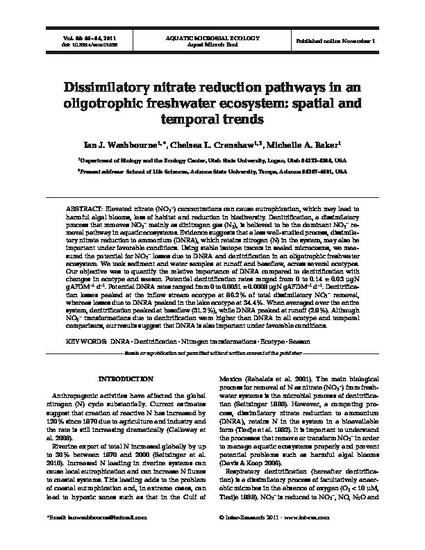
Article
Dissimilatory Nitrate Reduction Pathways in an Oligotrophic Freshwater Ecosystem: Spatial and Temporal Trends
Aquatic Microbial Ecology
(2011)
Abstract
Elevated nitrate (NO3−) concentrations can cause eutrophication, which may lead to harmful algal blooms, loss of habitat and reduction in biodiversity. Denitrification, a dissimilatory process that removes NO3− mainly as dinitrogen gas (N2), is believed to be the dominant NO3− removal pathway in aquatic ecosystems. Evidence suggests that a less well-studied process, dissimilatory nitrate reduction to ammonium (DNRA), which retains nitrogen (N) in the system, may also be important under favorable conditions. Using stable isotope tracers in sealed microcosms, we measured the potential for NO3− losses due to DNRA and denitrification in an oligotrophic freshwater ecosystem. We took sediment and water samples at runoff and baseflow, across several ecotypes. Our objective was to quantify the relative importance of DNRA compared to denitrification with changes in ecotype and season. Potential denitrification rates ranged from 0 to 0.14 ± 0.03 µgN gAFDM−1 d−1. Potential DNRA rates ranged from 0 to 0.0051 ± 0.0008 µgN gAFDM−1 d−1. Denitrification losses peaked at the inflow stream ecotype at 96.2% of total dissimilatory NO3− removal, whereas losses due to DNRA peaked in the lake ecotype at 34.4%. When averaged over the entire system, denitrification peaked at baseflow (31.2%), while DNRA peaked at runoff (2.9%). Although NO3− transformations due to denitrification were higher than DNRA in all ecotype and temporal comparisons, our results suggest that DNRA is also important under favorable conditions.
Disciplines
Publication Date
2011
DOI
https://doi.org/10.3354/ame01538
Citation Information
Michelle A. Baker. "Dissimilatory Nitrate Reduction Pathways in an Oligotrophic Freshwater Ecosystem: Spatial and Temporal Trends" Aquatic Microbial Ecology Vol. 65 (2011) p. 55 - 64 Available at: http://works.bepress.com/michelle_baker/83/
